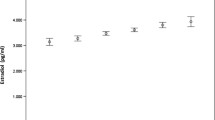Abstract
Purpose
In order to identify parameters which predict prognosis for success with in vitro fertilization, 17-hydroxyprogesterone and progesterone levels were evaluated in 254 patients undergoing 296 in vitro fertilization cycles. Selected response and outcome data were recorded.
Results
Patients with intermediate values of serum progesterone (0.7–0.8 ng/ml) at the time of human chorionic gonadotropin administration achieved significantly higher pregnancy rates than patients with lower (<0.7 ng/ml) or higher (>0.8 ng/ml) levels. The clinical pregnancy rates were 46%, 31%, and 27% respectively (P = 0.02). There was no change in 17-hydroxyprogesterone concentration which predicted a higher pregnancy rate.
Conclusion
Excellent clinical pregnancy rates were noted in cycles with a progesterone level of 0.7–0.8 ng/ml, as well as good results in cycles above 0.8 ng/ml. There is therefore no reason to administer human chorionic gonadotropin at a smaller follicle size to prevent a rise in serum progesterone.
Similar content being viewed by others
References
Meldrum DR, Wisot A, Hamilton F, Gutlay AL, Kempton W, Huynh: Routine pituitary suppression with leuprolide before ovarian stimulation for oocyte retrieval. Fertil Steril 1989;51:455
Lejeune B, Degueldre M, Camus M, Vekemans M, Opsomer L, Leroy F: In vitro fertilization and embryo transfer as related to endogenous luteinizing hormone rise or human chorionic gonadotropin administration. Fertil Steril 1986;45: 377–383
Stanger JD, Yovich JL: Reduced in-vitro fertilization of human oocytes from patients with raised basal luteinizing hormone levels during the follicular phase. Br J Obstet Gynaecol 1985;92:85–93
Kagawa T, Shuji Y, Souya N, Shinji M, Toshihiro A: Relationship among serum levels of luteinizing hormone, estradiol, and progesterone during follicle stimulation and results of in vitro fertilization and embryo transfer (IVF-ET). J Asst Reprod Genet 1992;9:106–112
Dirnfield M, Goldman S, Gonen Y, Koifman M, Lissak A, Abramovici H: A modest increase in serum progesterone levels on the day of human chorionic gonadotropin (hCG) administration may influence pregnancy rate and pregnancy loss in vitro fertilization-embryo transfer (IVF-ET) patients. J Asst Reprod Genet 1993;10:126–129
Schoolcraft W, Sinton E, Schlenker T, Huynh D, Hamilton F, Meldrum DR: Lower pregnancy rate with premature luteinization during pituitary suppression with leuprolide acetate. Fertil Steril 1991;55:563–566
Silverberg K, Burns W, Olive D, Reihl R, Schenken R: Serum progesterone levels predict success of in vitro fertilization/embryo transfer in patients stimulated with leuprolide acetate and human menopausal gonadotropins. J Clin Endocrinol Metab 1990;73:797–803
Edelstein MC, Steltman HJ, Cox BJ, Robinson SM, Shaw RA, Muasher SJ: Progesterone levels on the day of human chorionic gonadotropin administration in cycles with gonadotropin-releasing hormone agonist suppression are not predictive of pregnancy outcome. Fertil Steril 1990;54:853–857
Givens CR, Shriock ED, Dandekar PV, Martin MC: Elevated serum gonadotropin levels on the day of human chorionic gonadotropin administration do not predict outcome in assisted reproduction cycles. Fertil Steril 1994;62:1011–1017
Daly D, Hager M, VanderVeen H, Sokolowski SB: Using the increase in 17-OH progesterone as the hCG trigger during hMG therapy. Abstract #O-130, The American Fertility Society Annual Meeting, 1993
deZiegler D, Cedars MI, Randle D, Lu JKH, Judd HL, Meldrum DR: Suppression of the ovary using a gonadotropin-releasing hormone agonist prior to stimulation for oocyte retrieval. Fertil Steril 1987;48:807
Palermo R, Amodeo G, Navot D, Rosenwaks Z, Cittadini E: Concomitant gonadotropin-releasing hormone agonist and menotropin treatment for the synchronized induction of multiple follicles. Fertil Steril 1988;49:290
Levy MJ, Engel D, Nelson KM, Feldman P, Sagoskin A: Microinsemination of oocytes as an effective treatment of severe male factor infertility. Abstract #P-008, The American Fertility Society Annual Meeting, 1993
Silverberg KM, Martin M, Olive DL, Burns W, Schenken RS: Elevated serum progesterone levels on the day of human chorionic gonadotropin administration in in vitro fertilization cycles do not adversely affect embryo quality. Fertil Steril 1994;61:508–513
Mio Y, Sekijima A, Iwabe T, Onohara Y, Harada T, Terakawa N: Suble rise in serum progesterone during the follicular phase as a predictor of the outcome of in vitro fertilization. Fertil Steril 1992;58:159–166
Feldberg D, Goldman G, Ashkenazi J, Dicker D, Shelef M, Goldman J. The impact of high progesterone levels in the follicular phase of in vitro fertilization (IVF) cycles: a comparative study. J In Vitro Fert Embryo Transf 1989;6:11–14
Fanchin R, deZiegler D, Taieb J, Hazout A, Frydman R: Premature elevation of plasma progesterone alters pregnancy rates of in vitro fertilization and embryo transfer. Fertil Steril 1993;59:1090–1094
Trounson AO, Calabrese R: Changes in plasma progesterone concentrations around the time of the luteinizing hormone surge in women super-ovulated for in vitro fertilization. J Clin Endocrinol Metab 1984;59:1075–1080
Moor RM, Polge C, Willadsen SM: Effects of follicular steroids on the maturation and fertilization of mammalian oocytes. J Embryol Exp Morphol 1980,56:319–335
Hofmann GE, Bentzien F, Bergh PA, Garrisi GJ, Williams MC, Guzman I,et al: Premature luteinization in controlled ovarian hyperstimulation has no adverse affect on oocyte and embryo quality. Fertil Steril 1993;60:675–679
Paulson RJ, Saur MV, Francis MM,et al: In vitro fertilization in unstimulated cycles: a clinical trial using hCG for timing of follicle aspiration. Obstet Gynecol 1990;76:788
Foulot H, Ranoux C, Dubisson JB,et al: In vitro fertilization without ovarian stimulation: a simplified protocol applied in 80 cycles. Fertil Steril 1989;52:617
Levy M, Gindoff P, Hall J,et al: The efficacy of natural versus stimulated cycle IVF-ET. Abstract #0-035, The American Fertility Society Annual Meeting, 1991
Author information
Authors and Affiliations
Rights and permissions
About this article
Cite this article
Levy, M.J., Smotrich, D.B., Widra, E.A. et al. The predictive value of serum progesterone and 17-OH progesterone levels onin vitro fertilization outcome. J Assist Reprod Genet 12, 161–166 (1995). https://doi.org/10.1007/BF02211792
Received:
Accepted:
Issue Date:
DOI: https://doi.org/10.1007/BF02211792




